The cruiser Prinz Eugen was the largest and most modern German surface ship to survive WWII intact. Allocated to the United States, the ship briefly served as USS Prinz Eugen (IX-300), having some equipment stripped off for study and then being expended as an atomic bomb target.
Basic characteristics
Prinz Eugen was a Hipper class cruiser, launched in 1938 and commissioned 1 August 1940. The ship displaced 18,750 tons and measured 697’2″x71’2″x24′, with a crew of 42 officers and 1,340 enlisted sailors. Prinz Eugen was powered by twelve Krupp boilers for three Blohm & Voss geared steam turbines, with three shafts and turning three-bladed bronze propellers. Maximum speed was 32 kts.
Prinz Eugen was well armed with eight 8″ guns in four twin turrets, each armored with 4″ steel. The secondary armament was twelve 105mm guns in six twin turrets, twenty 40mm and eighteen 20mm AA guns, and twelve torpedo tubes. There was one catapult and a hangar for three seaplanes. The cruiser had a 3″ armor belt and was equipped with the most modern WWII German radars, sonars, and radios.
During the war, Prinz Eugen was most famous as the partner of Bismarck when that battleship sank the British battleship HMS Hood.
Prinz Eugen at the end of WWII
In April 1945, with Germany crumbling, Prinz Eugen sailed to Copenhagen in occupied Denmark. On 8 May 1945, Germany surrendered. The following day, an advance team of British troops reached Copenhagen and took custody of Prinz Eugen for the UK. Most of the ship’s ammunition was offloaded as a security measure. On 27 May 1945, a mixed crew of surrendered German sailors and Royal Navy personnel sailed Prinz Eugen from Copenhagen to Wilhelmshaven in occupied Germany.
Throughout the summer of 1945, the victorious allies deliberated on how to divvy up the remains of the German navy. The British and Americans were quite aware of the advanced electronics on Prinz Eugen and were determined that the USSR not see it, and it was decided that the best way to accomplish this would be to get the cruiser out of Europe.
 (Prinz Eugen in late 1945, still unaltered from it’s WWII appearance but now flying the American flag.)
(Prinz Eugen in late 1945, still unaltered from it’s WWII appearance but now flying the American flag.)
On 13 December 1945, the British allocated Prinz Eugen to the US Navy, who moved the cruiser to Wesermunde, a central base for the US Navy’s occupation team in Germany. The ship was recommissioned USS Prinz Eugen, hull number IX-300 (“IX” is the US Navy’s “miscellaneous” category; there was never any intention to actually use the ship as a cruiser). It’s somewhat notable that the ship was formally placed in commission, as many war prizes (including the Japanese battleship IJN Nagato) were simply listed as “uncommissioned Navy property”. It’s also somewhat unusual that the German name was retained.
On 13 January 1946, USS Prinz Eugen left Europe for the final time, bound for the USA with a mixed German and American crew.
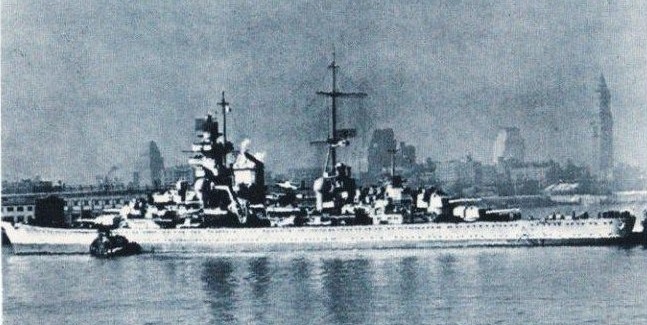 (USS Prinz Eugen arrives in Boston, MA on 22 January 1946.)
(USS Prinz Eugen arrives in Boston, MA on 22 January 1946.)
USS Prinz Eugen in US Navy service
After a brief stopover in Boston, MA to take on fuel and food, USS Prinz Eugen sailed south to Philadelphia Naval Shipyard, PA. There, the ship received some minor changes and more importantly, some of the equipment was stripped off.
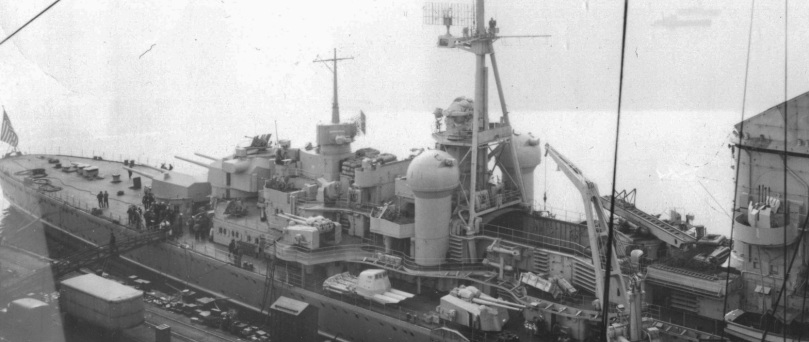 (USS Prinz Eugen in Philadelphia, February 1946. This photo shows the seaplane hangar open.)
(USS Prinz Eugen in Philadelphia, February 1946. This photo shows the seaplane hangar open.)
Some galley equipment was replaced by US Navy-standard cooking gear. Enlisted American sailors did not like the German-style hammocks, so portable hospital bunks were installed for the American crew. All of the ships dials and gauges were painstakingly translated and affixed with English stickers.
The German crew members
The ex-Kriegsmarine sailors were referred to as “detained enemy personnel” as they were technically not POWs but not free to leave either. They were paid $27 to $64 per month (a US Navy seamen made $66 per month in 1946). The crew included the final WWII captain, Cpt. Hans-Jurgen Reincke. The enlisted Germans had their own quarters aboard ship and fraternization between them and the Americans was discouraged. Likewise, the German officers had their own part of the wardroom, which was sectioned off by a green curtain. Germans and Americans dined separately on the mess deck.
German sailors were allowed to continue wearing their uniforms however they could not wear medals or reichsadlers (eagle with swastika emblem). The Germans maintained their rank structure including salutes. American sailors did not salute Germans of higher rank.
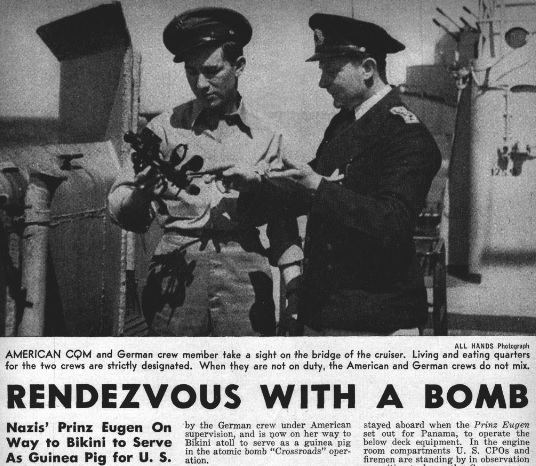 (From the April 1946 edition of All Hands, the US Navy’s magazine.)
(From the April 1946 edition of All Hands, the US Navy’s magazine.)
All in all, the Germans selected to remain on board after WWII did not have a bad deal as instead of a POW camp they had free food, pay, and normal living conditions. Some were dismissed as soon as the cruiser arrived in Boston. Many more left while the ship was in Philadelphia, and the final few when USS Prinz Eugen transited the Panama Canal. As a courtesy, Cpt. Reincke was the last to leave, on 1 May 1946. No Germans were aboard when USS Prinz Eugen arrived at Bikini.
The American crew
USS Prinz Eugen‘s American captain was Cpt. Arthur Graubart. Fluent in German, he had been the naval attache at the embassy in Berlin before the USA entered the war. He was easy-going and befriended many Kriegsmarine officers. Graubart was arrested by the Gestapo when the USA entered the war in 1941 and sent to a POW camp. In mid-1942, he was exchanged for detained German diplomats. Reportedly the high command of the Kriegsmarine insisted he be included in the exchange, as a courtesy.
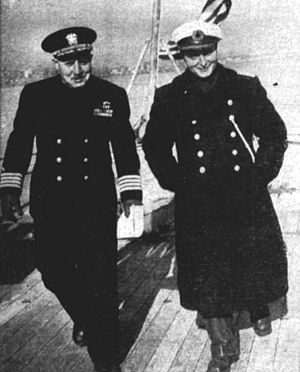 (Captain Graubart (left) and Captain Reincke (right) aboard USS Prinz Eugen in Philadelphia in early 1946.)
(Captain Graubart (left) and Captain Reincke (right) aboard USS Prinz Eugen in Philadelphia in early 1946.)
During WWII Graubart helped author a US Navy handbook on the Kriegsmarine. He was present in Europe for Germany’s surrender. Before taking command of USS Prinz Eugen, he was somewhat famous in the US Navy for stealing Adolf Hitler’s own nazi flag from Soviet guards who had secured it during the Battle Of Berlin (today the flag is at the US Naval Academy). Graubart was named the cruiser’s captain on 5 January 1946.
The remainder of the US Navy crew was little different than any other American warship. There were no personnel problems during the ship’s brief time under the stars & stripes.
Removal / Evaluation of WWII German weapon systems
The SK C/34 8″ gun
As the main armament of the ship, the US Navy was obviously interested in these guns. As they were sized in metric, they were actually 203mm (7.992″). They had a range of 15NM and each armored turret was allocated 280 rounds. After interviews with the German crew and inspection onboard, it was decided to remove two of the guns for ashore testing.
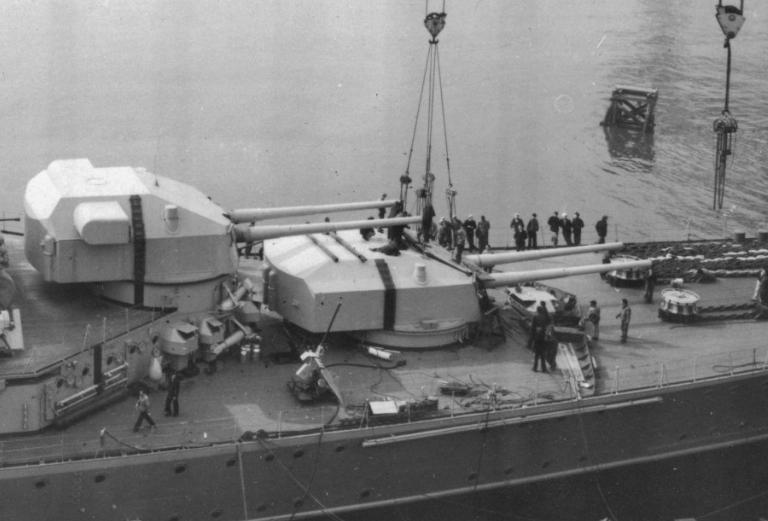 (Workers at Philadelphia Naval Shipyard extract the two guns from USS Prinz Eugen’s “A” turret in February 1946.)
(Workers at Philadelphia Naval Shipyard extract the two guns from USS Prinz Eugen’s “A” turret in February 1946.)
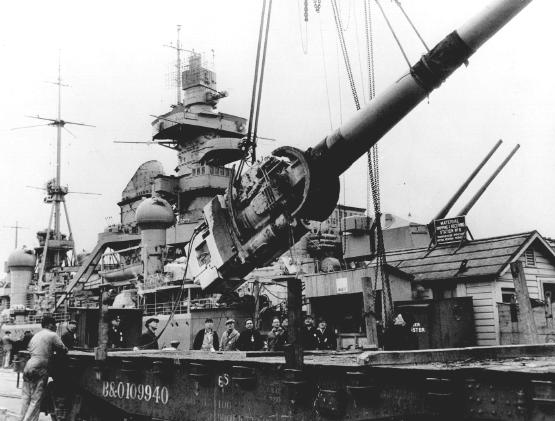 (One of the extracted 8″ guns is loaded onto a flatbed railcar for transport.)
(One of the extracted 8″ guns is loaded onto a flatbed railcar for transport.)
The two guns were sent to the Naval Weapons Station at Dahlgren, VA, where one was test-fired from an ashore mount. Whereas most of the captured German, Japanese, and Italian ship weapons were judged poorly, the SK C/34 8″ was found to be equal or better than WWII-era American guns of it’s caliber. The US Navy had already moved on to the Mk16RF 8″ gun, which turned out to be the final American 8″ gun in service, so much of the data was just historically interesting only. One of the guns was scrapped, the other placed in storage. The “A” turret on USS Prinz Eugen was reassembled without guns, and the two openings plated over.
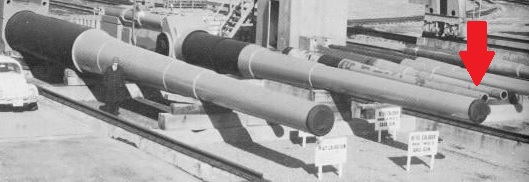 (The SK C/34 8″ is the right-most muzzle showing. The gun just to the left is a prototype Mk16RF 8″, while the two to the left of that are battleship guns. These guns are stored at the Naval Surface Warfare Center in Virginia today.)
(The SK C/34 8″ is the right-most muzzle showing. The gun just to the left is a prototype Mk16RF 8″, while the two to the left of that are battleship guns. These guns are stored at the Naval Surface Warfare Center in Virginia today.)
The SK C/33 105mm gun
This twin gun had a range of 9NM and was originally intended as a dual-purpose weapon. However as aircraft became more advanced during WWII it was used almost exclusively as an anti-aircraft gun. The US Navy had little interest in the gun design, but was very interested in the triaxial stabilization system.
The Flak-28 40mm AA gun
These AA guns were added by the Germans during the war. They were based on the Bofors operating principle (same as the US Navy’s Mk4 40mm of WWII) and used similar ammunition. As such, there was little to be learned from them.
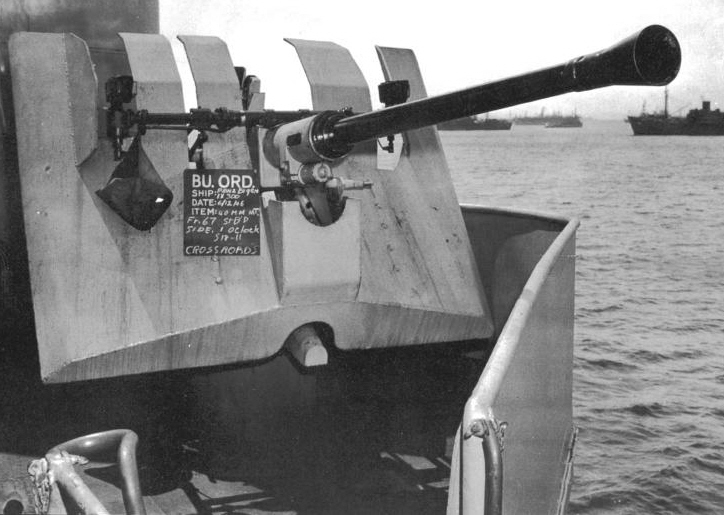 (The US Navy Bureau Of Ordnance sign shows that the photo was taken during the Operation Crossroads preparation at Bikini.)
(The US Navy Bureau Of Ordnance sign shows that the photo was taken during the Operation Crossroads preparation at Bikini.)
The Flakvierling L38 20mm AA gun
This was just a basic close-range anti-aircraft gun. One was removed and shipped to Virginia along with the two 8″ weapons. Test-firing there showed it to be no better than WWII-era 20mm AA guns already in American service, which the US Navy was already starting to phase out after the war.
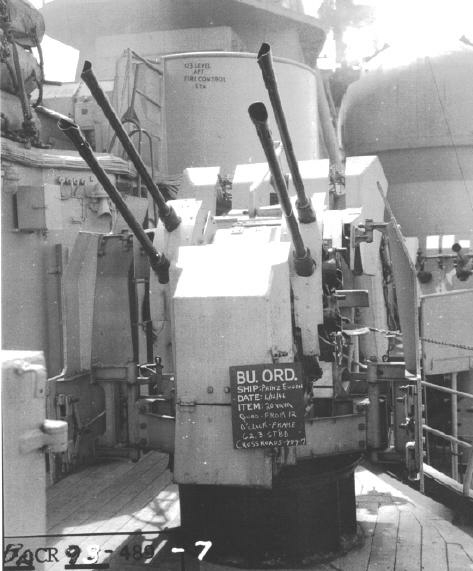 (One of the quad 20mm mounts with a Bureau Of Ordnance placard at Bikini. The muzzle of a 40mm gun is visible in the background, as is the dome of one of the AA fire control directors. Hand-painted English nearby indicates it’s one of the aft directors.)
(One of the quad 20mm mounts with a Bureau Of Ordnance placard at Bikini. The muzzle of a 40mm gun is visible in the background, as is the dome of one of the AA fire control directors. Hand-painted English nearby indicates it’s one of the aft directors.)
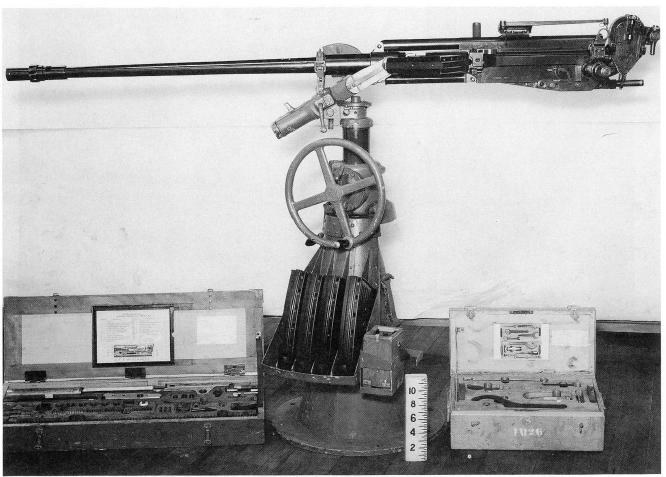 (The 20mm gun which was dismounted and sent to Virginia for ashore tests.)
(The 20mm gun which was dismounted and sent to Virginia for ashore tests.)
Torpedoes
Prinz Eugen was equipped with four triple anti-ship torpedo tube banks, firing G7a torpedoes. Each of the four banks had it’s own three-round reload magazine. The US Navy already had acquired G7a torpedoes off the captured U-505 during WWII. None the less, some of the torpedoes, and one of the triple tubes, was removed for ashore study.
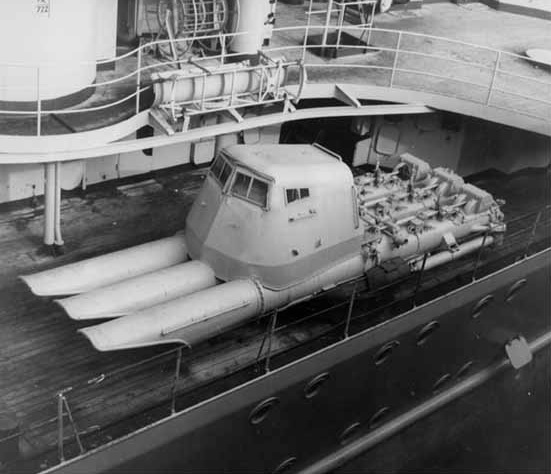 (A torpedo tube bank aboard USS Prinz Eugen, photographed while the ship was in the Panama Canal in 1946. The I-beam overhead moved reloads from the magazine to the tubes.)
(A torpedo tube bank aboard USS Prinz Eugen, photographed while the ship was in the Panama Canal in 1946. The I-beam overhead moved reloads from the magazine to the tubes.)
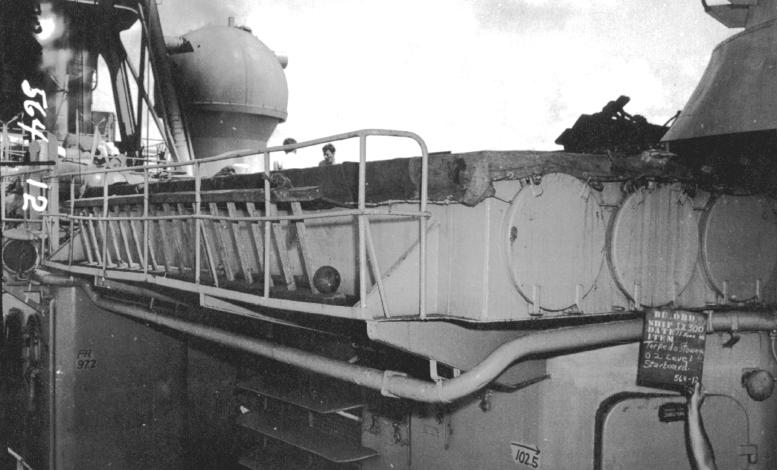 (One of the armored torpedo reload magazines with a US Navy identification sign. Judging from the location it is the starboard aft magazine.)
(One of the armored torpedo reload magazines with a US Navy identification sign. Judging from the location it is the starboard aft magazine.)
Aircraft
Two of Prinz Eugen‘s three Arado Ar-196 seaplanes were still aboard when the British seized the ship in Copenhagen. One was apparently inoperable and was unloaded in Philadelphia and sent to the Smithsonian, where it remains boxed up today. The other was test-flown by personnel of Naval Air Station Willow Grove, PA. When USS Prinz Eugen prepared to leave for Bikini, both the plane and it’s catapult were removed by Philadelphia Naval Shipyard. The catapult was mounted ashore and used for additional test flights in 1947. The tests showed the Ar-196 to be a generally good seaplane, however the US Navy was already preparing to switch to helicopters.
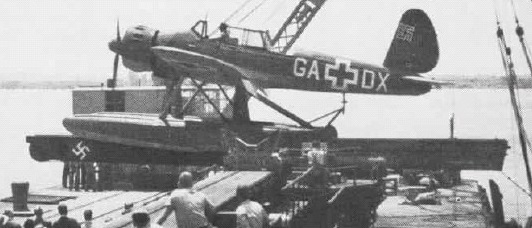 (The Ar-196 is revved up on the removed catapult at Philadelphia in 1947. After WWII, basic American markings had been applied. Later, for entertainment of the media, crude “German” markings were re-applied. The iron cross is the wrong shape and size, and the swastika on the tail is in the wrong location and tilted wrong. The swastika on the catapult was added by the Americans, as the Germans did not mark the catapult in that way.)
(The Ar-196 is revved up on the removed catapult at Philadelphia in 1947. After WWII, basic American markings had been applied. Later, for entertainment of the media, crude “German” markings were re-applied. The iron cross is the wrong shape and size, and the swastika on the tail is in the wrong location and tilted wrong. The swastika on the catapult was added by the Americans, as the Germans did not mark the catapult in that way.)
After the test flights, the Ar-196 was stored outdoors in Pennsylvania for many years, then transferred to Florida. In 2013 it was sent to a naval museum in Germany. The crated Ar-196 remains at the Smithsonian. These are two of the three Ar-196s that remain in the world in 2015; the third being at the Bulgarian navy museum.
The FuMo 25 radar
This rectangular antenna was carried on the aft mast. It was just a general-purpose radar with a range of about 10NM.
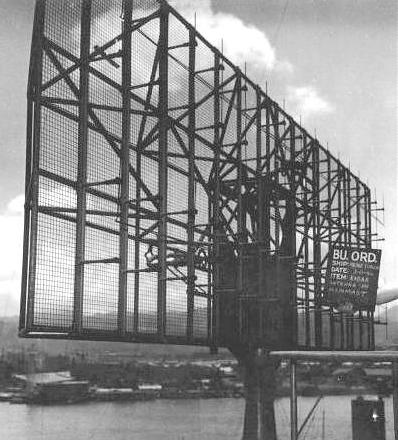 This system was already obsolete even when compared to WWII-era American radars, let alone the first postwar models, and little was done in the way of exploiting it’s technology.
This system was already obsolete even when compared to WWII-era American radars, let alone the first postwar models, and little was done in the way of exploiting it’s technology.
The FuMo 26 radar
This was the most visible of Prinz Eugen‘s radars, being carried on the rangefinder atop the conning tower. It was a ship-to-ship gunnery radar. The basic model had a range of 13 NM.
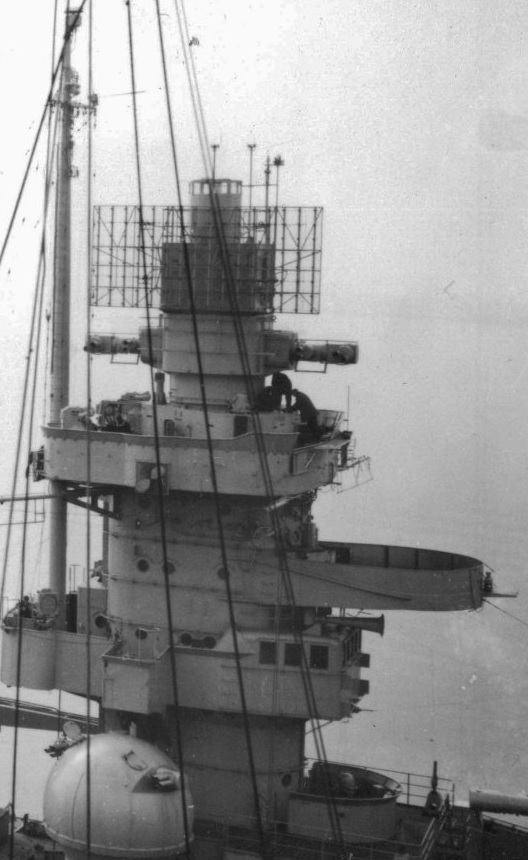 (USS Prinz Eugen at Philadelphia Naval Shipyard in February 1946. This photo shows the large FuMo 26 antenna on the optical rangefinder with it’s “bug eye” optics. On the side of the catwalk beneath, is a Sumatra ESM antenna (the figure-8 in a square). Atop the bridge is the ship’s whistle, and at the bottom of the photo is the forward starboard AA gunnery director dome which itself was removed for ashore study. In the lower righthand corner is an arm of the forward Zeiss rangefinder, which was also taken ashore for study.)
(USS Prinz Eugen at Philadelphia Naval Shipyard in February 1946. This photo shows the large FuMo 26 antenna on the optical rangefinder with it’s “bug eye” optics. On the side of the catwalk beneath, is a Sumatra ESM antenna (the figure-8 in a square). Atop the bridge is the ship’s whistle, and at the bottom of the photo is the forward starboard AA gunnery director dome which itself was removed for ashore study. In the lower righthand corner is an arm of the forward Zeiss rangefinder, which was also taken ashore for study.)
The German sailors told the Americans that their ship’s FuMo 26 was an upgraded, even more advanced model with a short 4 microsecond pulse and a range of 21NM. This upgraded model had accuracy of ±55 yards and the Germans considered it sufficient for “blind” targeting of enemy cruisers or battleships. Perhaps due to it’s sophisticated nature, the US Navy personnel never quite mastered the FuMo 26 in the short time the cruiser was on the East Coast. It was decided to leave it aboard to witness the effects of a nuclear blast upon a high-end foreign radar.
The FuMo 27 radar
This radar was carried on the aft rangefinder. It’s only function was to measure the distance to a targeted ship.
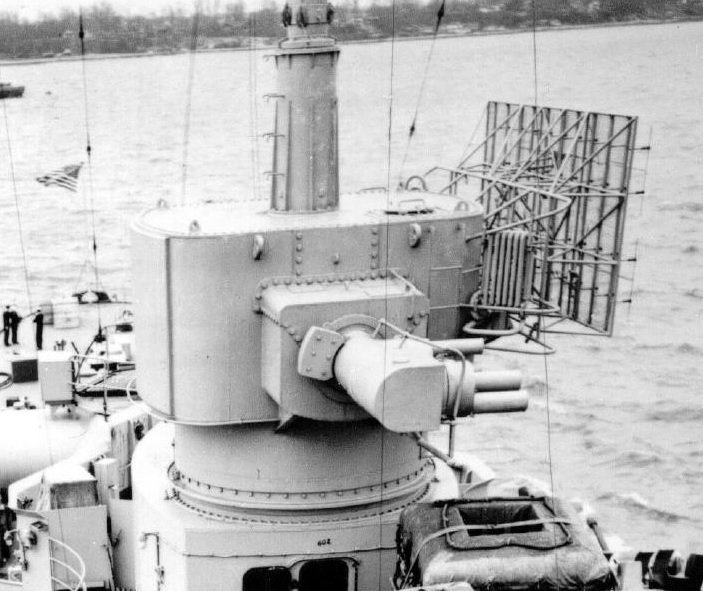 This radar had constant technical problems when the cruiser was in American service. Little was done to study it.
This radar had constant technical problems when the cruiser was in American service. Little was done to study it.
The FuMo 81 Berlin-S radar
This small antenna was carried atop the main mast. It was a high-frequency radar used to localize targets detected by other radars. It was judged inferior to existing US Navy radars.
The FuMB 4 Sumatra ESM system
These small antennas on the conning tower intercepted enemy radar transmissions and warned the captain if Prinz Eugen was “being painted” (targeted by an enemy gunnery radar). The US Navy personnel considered it of average abilities.
The GHG sonar system
For certain, this was the greatest prize of all taken off the German cruiser. The GHG sonar was, by WWII standards, very advanced. It had a spaced array of multiple crystal hydrophones with electric signal delays. This radar could detect a ship out to 10NM in quiet conditions, and because of the signal delaying, it was possible to determine a contact’s bearing and course.
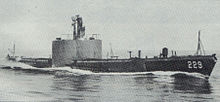 (The submarine USS Flying Fish (SS-229) in 1952, with Prinz Eugen’s GHG sonar installed around the conning tower.)
(The submarine USS Flying Fish (SS-229) in 1952, with Prinz Eugen’s GHG sonar installed around the conning tower.)
The GHG sonar was removed off USS Prinz Eugen and installed on the WWII-veteran submarine USS Flying Fish (SS-229) for further tests. The results can not be understated, as the experiments gave the US Navy a big head start in the Cold War sonar race with the Soviets. The AN/BQR-4 sonar aboard 1950s-era US Navy submarines was a direct descendant of the GHG, and later Cold War sonars still had some vestiges of it’s technology.
Destruction of USS Prinz Eugen
In early 1946, it was decided to expend the war prize USS Prinz Eugen as a test for Operation Crossroads, a series of nuclear tests at the Pacific atoll of Bikini. These tests would be the first time that warships were exposed to atomic weapons. Prior to the voyage, once all equipment of further interest had been removed, workers at Philadelphia Naval Shipyard installed an American WWII-surplus Type SQ radar for safe navigation. The US Army donated a SCR-584 radar van with wheels removed, which was lashed onto the platform of the removed forward rangefinder with two steel cables. This radar allowed USS Prinz Eugen to provide distances to friendly planes during it’s final voyage, also, the Army wanted to see how their gear held up to an atomic explosion. Professional to the end, the remaining Germans onboard repainted the SCR-584 haze grey so the Army OD green would not stick out. Additional drinking water capacity was added for the journey through the hot Caribbean.
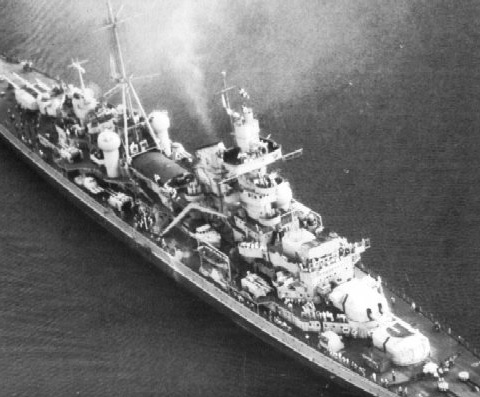 (USS Prinz Eugen departs Philadelphia for the last time in March 1946. This photo shows the now-empty seaplane hangar closed. The catapult has been removed.)
(USS Prinz Eugen departs Philadelphia for the last time in March 1946. This photo shows the now-empty seaplane hangar closed. The catapult has been removed.)
(USS Prinz Eugen westbound in the Gatun Locks of the Panama Canal in 1946. This photo shows the de-gunned “A” turret, the missing forward starboard AA director dome, and the SCR-584 trailer lashed below the bridge with it’s dish pointing forwards. The black box on the deck next to “A” turret contains crated scientific gear which the cruiser brought to Bikini as deck cargo.)
(USS Prinz Eugen on 14 June 1946, arrived at Bikini Atoll. By this time all Germans had left and without their help, the #3 boiler and most of the radars were not functional. The big white hash marks painted on the hull were so that any list on target ships could be determined from a distance through binoculars. The small numbers at irregular intervals just below the main deck are internal frame markers for damage assessment.)
Test Able – 1 July 1946
Test Able was an airburst over the anchored target fleet. The bomb was an exact duplicate of the “Fat Man” used on Nagasaki. It was the fourth atomic weapon ever built and was destined for combat use had Japan not surrendered. It was dropped on the Bikini target fleet from a WWII-vintage B-29 Superfortress. The crew painted a pin-up style portrait of the movie star Rita Hayworth on the weapon.
Aboard the cruiser, the final steps were to take photographs of key equipment in their final positions. The ship’s bell (still with it’s swastika) was removed and given to the US Navy Museum, and the American flag was hauled down. The crew then departed to the “monitoring fleet” further away from the target ships.
The bomb detonated at an altitude of 520′ above the target ships with a yield of 21kT. The intended ground zero (the old battleship USS Nevada) was missed by 710 yards and the detonation happened far westward of where it was intended. The result was that Prinz Eugen was more than a mile and a half from the detonation. It had been intended that the ship take the blast sideways starboard, but currents before the test had swung Prinz Eugen around so that the blast arrived on the extreme forward bows, limiting it’s effect somewhat.
The initial effect of the airburst on the ships was a thermal flash; a brief period of very intense heat. Several seconds later, the blast wave arrived. This was as high as 700kts inside 1,000 yards of ground zero but was less by the time it reached Prinz Eugen. Finally there was fallout; as Test Able was an airburst little water and no solid material was sucked up by the detonation so this was minimal. Radiation aboard Prinz Eugen was judged safe (by 1940s thinking) for a damage control team to reboard the next day.
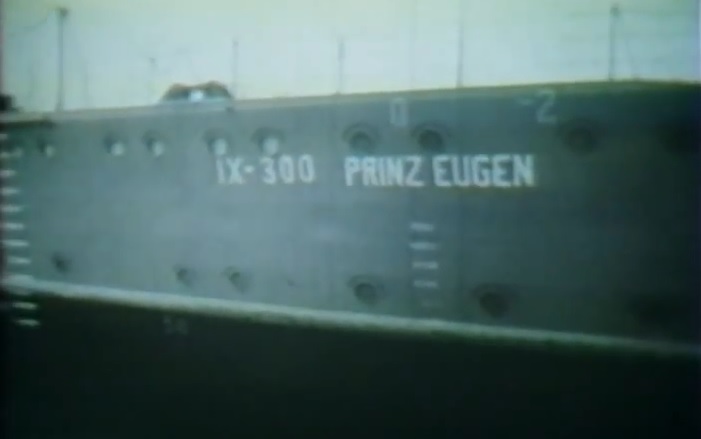 (The stern after Test Able, showing very little to no hull damage. The list hash marks and frame numbers are visible.) (US Department of Energy photo)
(The stern after Test Able, showing very little to no hull damage. The list hash marks and frame numbers are visible.) (US Department of Energy photo)
Damage from Test Able
Damage to Prinz Eugen was much less than had been anticipated. The most notable item was that the seaplane hangar was completely destroyed, caved in from above by the blast wave. The bridge windows were blown out by the blast wave, as were some of the searchlights. There were only slight instances of structural damage. The deck near “B” turret buckled against the turret ring. The US Navy estimated this was from the blast wave hitting the deck and turret armor face at different angles. The entire rangefinder atop the conning tower was damaged, with it’s retaining bolts being sheared. The US Navy estimated that the FuMo 26 antenna acted like a parachute, “catching” the blast wave and lifting the whole assembly up and then down about 3 ½” off-kilter.
All of the radars were destroyed. Although the external antennas appeared intact, the internal circuits were destroyed by the blast wave, heat, and electromagnetic pulse. The temporary Type SQ radar was ripped off. The main mast (which was wood) split down the middle with the top 14 ½’ section bent away from ground zero. Amazingly, the SQR-584 trailer was not only intact, but still securely held by the two steel cables.
None of the guns were damaged. One of the torpedo tube banks was damaged but the live weapons inside did not detonate. The captain’s boat was slightly damaged and many German liferafts were blown overboard by the blast wave.
The blast wave distorted some areas of the deck downwards a slight bit. The thermal pulse scorched the ship’s paint and charred some wood deckplanks, but did not set the ship on fire. The heat was insufficient to “cook off” any ammunition onboard.
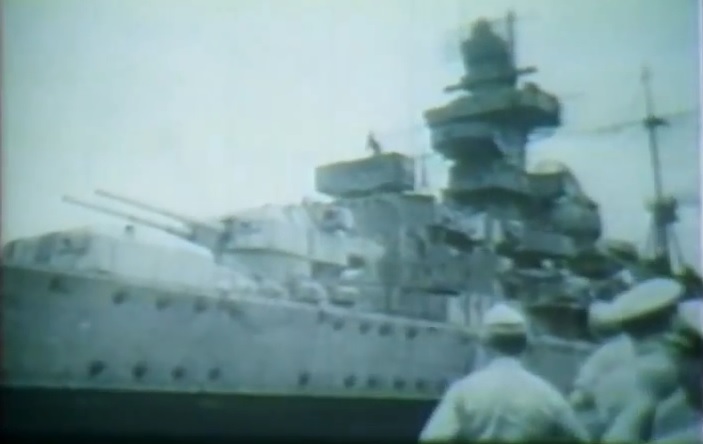 (The forward port area of Prinz Eugen, which was most facing the Test Able detonation. The paint is scorched but the ship is still largely undamaged.) (US Department of Energy photo)
(The forward port area of Prinz Eugen, which was most facing the Test Able detonation. The paint is scorched but the ship is still largely undamaged.) (US Department of Energy photo)
Internally, the only damage was to a bulkhead in the sick bay and some failed welds. No damage was done to the fuel tanks, which were still 50% full. The bilge pumps, ventilation, and electrical system were operational several days after Test Able. The US Navy noted that almost all of the German-made lightbulbs onboard broke, while most of the American-made ones did not. One round hull window had accidentally been left open; the room the window served had moderate damage to it’s bulkheads. All in all, the damage from Test Able was unremarkable and might be expected from a conventional naval battle.
Test Baker – 25 July 1946
Test Baker was the first underwater atomic detonation in history. The weapon was a Mk3 bomb, which was suspended 90′ on a cable beneath a WWII-surplus landing craft (which was obviously vaporized in the test). For Test Baker, Prinz Eugen was about 1,750 yards away from the underwater 21kt blast, this time with her port side facing it.
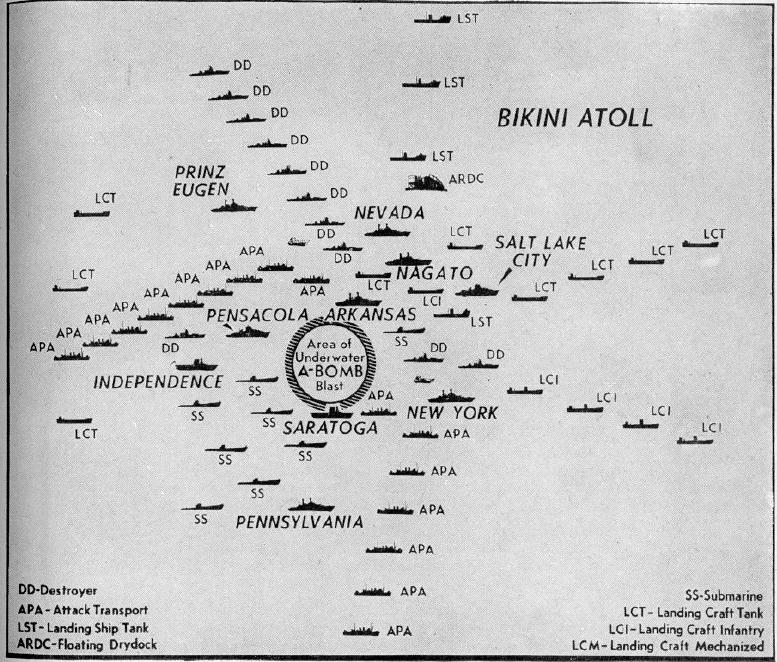 (General location of ships for Test Baker.)
(General location of ships for Test Baker.)
As the bomb exploded underwater, there was no thermal flash. The detonation gouged a crated 30′ deep into the coral seabed and threw a geyser of radioactive seawater and pulverized coral 6,000′ into the air. The two million tons of water then fell back down onto the nearest ships.
The most devastating effect was the violent underwater shock, which hit Prinz Eugen‘s hull traveling hundreds of miles per hour. A second smaller jolt followed; this was a reflected wave off the seafloor. Almost immediately, a wave of water from the other direction rushed underneath the ship, filling the void of the expelled water before being pushed back the other direction as the geyser came back down.
What came next was unexpected and turned out to be the most dangerous part of Test Baker. A rolling 900′-tall fog of very radioactive seaspray expanded outwards over the surface of the lagoon. This phenomenon, called a base surge, had not been predicted during pre-test experiments. The wall of massively radioactive water droplets covered every ship it touched, soaking them in every nook and cranny with radiation.
Damage from Test Baker
As all of the shock from Test Baker was underwater, nothing above the waterline externally was affected.
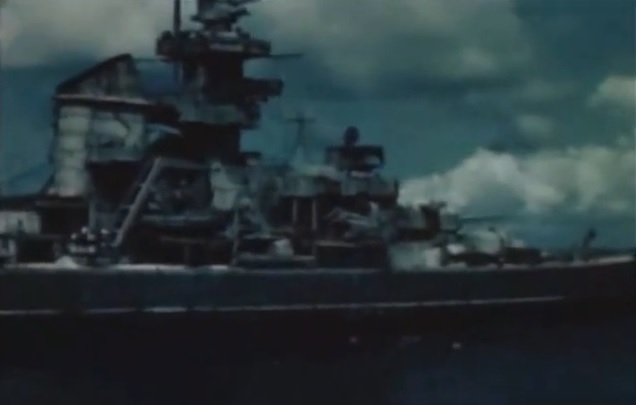 (Prinz Eugen shortly after Test Baker. All the scorching visible was from Test Able. Not visible is the massive amount of radiation on the ship.)
(Prinz Eugen shortly after Test Baker. All the scorching visible was from Test Able. Not visible is the massive amount of radiation on the ship.)
The most serious structural damage was a sea valve blown open which flooded the aft engine room with 3′ of standing radioactive water. This resulted in an immediate 1.5° list which eventually was the ship’s downfall. Smaller flooding was caused by the seal on the rudder post failing. Many of the ship’s small electrical motors were grounded out, and some ventilation ducts had buckled.
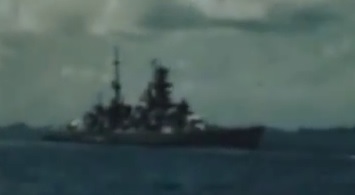 (Prinz Eugen beginning to list to starboard after Test Baker.)
(Prinz Eugen beginning to list to starboard after Test Baker.)
Some of the items that were not damaged were surprising. The anchor windlass was operated successfully, despite the strain which must have been placed on the anchor chain. The rudder operated normally despite enduring the underwater shock.
Prinz Eugen was unbelievably radioactive after Test Baker. It had been planned to re-man the vessel two or three days later, however the radiation was so strong that it was almost a month before personnel could stay aboard for any length of time. Early on, the radioactivity was so strong that it threw a geiger counter out of calibration. Like most of the other Test Baker ships, decontamination efforts completely failed. At first, tugboats sprayed down the ship. They were using lagoon water which itself was radioactive, and this didn’t help any and probably made things worse. Firefighting foam was tried with no effect. When sailors were allowed onboard, they tried scrubbing the deck with navy soap, then with lye; neither of which did anything.
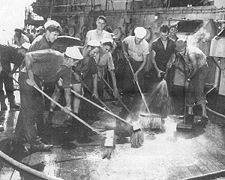 (US Navy sailors – some barefoot – scrub Prinz Eugen’s radioactive deck in 1946.)
(US Navy sailors – some barefoot – scrub Prinz Eugen’s radioactive deck in 1946.)
Because of the radioactivity, and the winding-up of Operation Crossroads, it was not feasible to repair the damage deep in the hull. The efforts were discontinued as sailors were picking up fallout and contaminating the showers and laundries of other vessels. In August 1946, the ship was towed to the US Naval Station at Kwajalein Atoll.
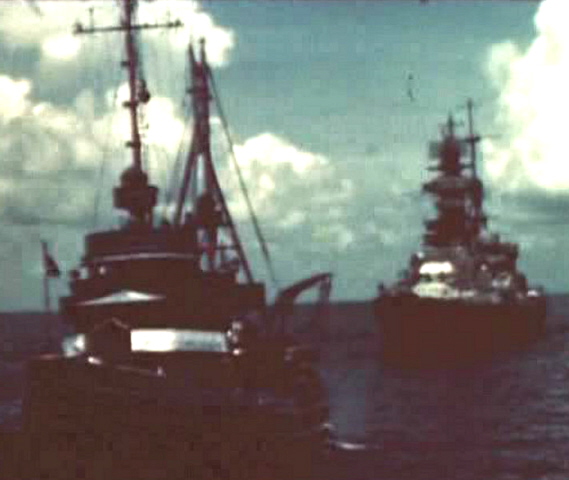 (The heavily-radioactive Prinz Eugen at Kwajalein Atoll, late 1946.)
(The heavily-radioactive Prinz Eugen at Kwajalein Atoll, late 1946.)
By Thanksgiving Day 1946, the flooding had restarted and the ship began to take a more noticeable list. On 21 December 1946, it appeared that the ship might capsize, and an urgent call was put out for any available US Navy salvage ship as there was none present at Kwajalein. None arrived in time. On 22 December 1946, a small harbor tug tried to shove the cruiser aground but just shy of the beach, Prinz Eugen capsized and sank.
The wreck
Prinz Eugen capsized at Enubuj Islet, a small piece of land at the tip of the atoll about 3 ½ miles from the town. As the ship rolled over, the four main gun turrets fell out, as did one of the AA director domes. The conning tower snapped off under the weight of the main hull and is pinned underneath it. The aft part of the ship, including the rudder and propellers, is always above the waterline and much of the hull is above at low tide. In 1997, Hurricane Paka rolled the hull a bit so that it is now almost perfectly upside down.
In August 1979, the radiation had subsided enough that a US Navy team could cut off one of the propellers. It was presented to West Germany as a gift and installed at the U-Boat Memorial at Laboe, where it remains today.
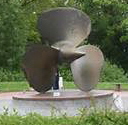 By the mid-1980s, the radiation had almost completely faded and the hull was opened to amateur scuba divers. In 1987, part of the aft lower hull plating (perhaps damaged by the Crossroads tests) rusted through and caved in. Otherwise this wreck with a strange history remains intact as of 2015.
By the mid-1980s, the radiation had almost completely faded and the hull was opened to amateur scuba divers. In 1987, part of the aft lower hull plating (perhaps damaged by the Crossroads tests) rusted through and caved in. Otherwise this wreck with a strange history remains intact as of 2015.

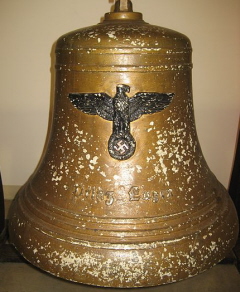
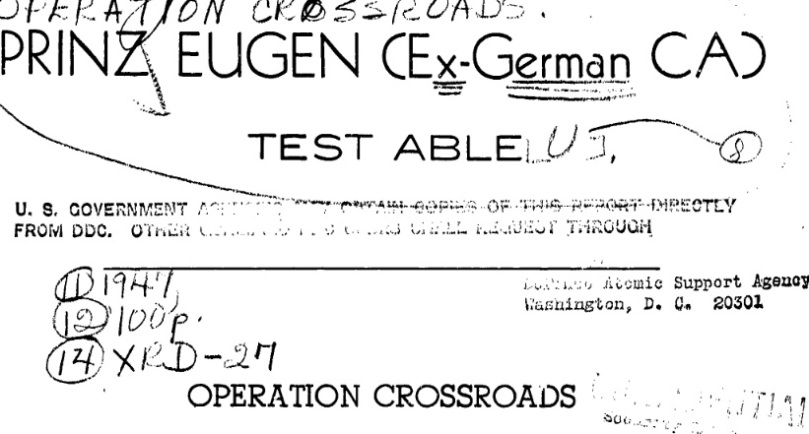
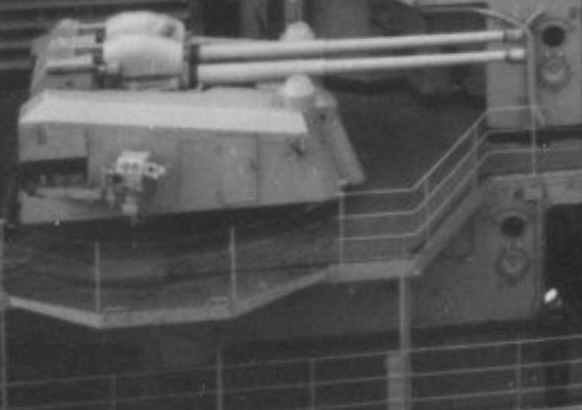
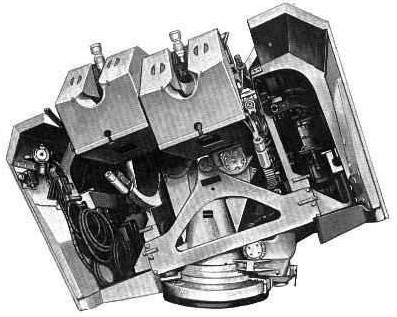
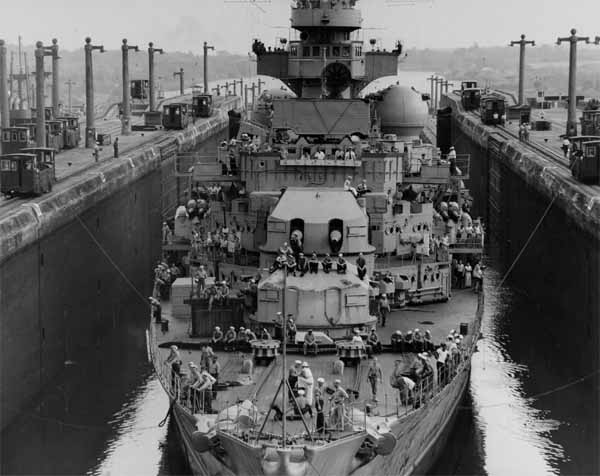
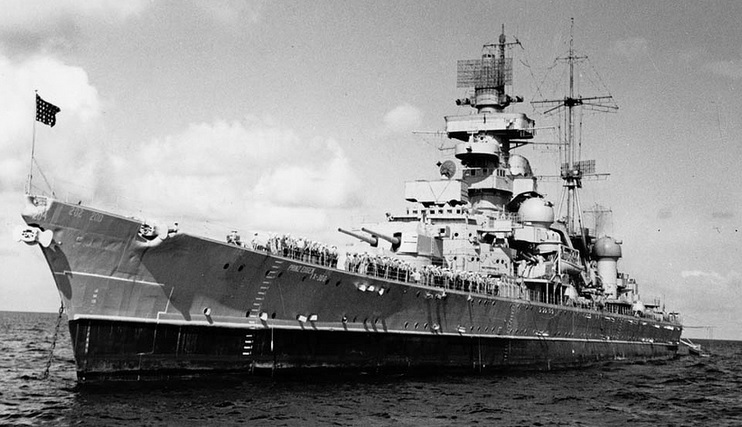
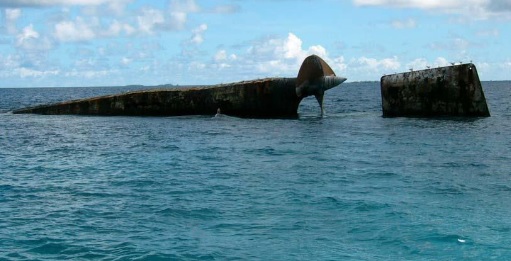
Reblogged this on Brittius.
LikeLike
My father was one of the crew that took the USS Prinz Eugen to the Bikini Atol. The crew were allowed to remove “Keepsakes ” before they left the ship. I have his prize, a candle holder, proudly hanging on the wall. It took me many years to realize how important this ship was in history, both during the war and after.
LikeLike
That is awesome, incredible keepsake for sure!
LikeLike
My Grandfather was one of the men who took possession of the ship. We have the Flag from the Prinz Eugen. The crew signed the flag.
LikeLiked by 1 person
That is outstanding! Do you still have the actual flag?
LikeLike
That is awesome that you have the flag. There are not a lot of people who even know about the ship, and every time I show someone the candle holder I get to tell the story.
God Bless the Greatest Generation.
LikeLike
I wonder if he was part of the same group as my grandfather.
LikeLike
My father was a CPO in the engine room on the BS Colorado, and was fluent in German. He volunteered to work in the engine room on the Prinz Eugen. Not only did he rescue the candle holder, but he brought a name plate from one piece of equipment. What was interesting about the name plate, is that it is plastic which may seem cheap, but plastic was actually not cheap in those days as it was a fairly new product, I believe, at that time.
LikeLiked by 1 person
That is outstanding! Most of the plastic (the little that there was) during WWII was bakelite, the “original” type of plastic invented.
LikeLike
Hello. my grandfather was a Norwegian merchant captain during World War II. my father was a marine engineer who worked for Sun Shipbuilding in Chester, Pa in the 70s. Heard many stories growing up. A truly detailed and astounding article. Many thanks.
LikeLiked by 1 person
Really enjoyed this article, my father also was on this ship on its journey to Bikini Atoll and a witness to the bomb tests. I have a sugar bowl and some propaganda liturature retrieved from this ship. He had told my mother that there was so many cockroaches they put the legs of the bunks in cans with oil so they would not get in the bunks. Thanks for the story.
LikeLiked by 1 person
Does anyone know where to get a complete crew list for that last trip to the Bikini Atol?
LikeLike
I would like to find that too. I have my father’s naval records and it’s pretty cool that it shows that he served on the USS Prinz Eugen!
LikeLike
If you find out how will you please share your findings.
LikeLike
My father was also on the crew of the Prinz Eugen. All I’ve got is the letter and envelope with the mushroom cloud postmark that he sent my grandmother after the tests. Unfortunately he died way too soon from cancer and was one of the forgotten atomic veterans from this test! I never hear about the animals that they left tied to the target ships. Then the crews went back on to see what happened to them.
LikeLiked by 1 person
Great comments. My father was a signal man on the Prinz Eugen. I have a pair of binoculars from the ship. He too was one of the sailors who witnessed the Able and Baker test bombs.
LikeLike
My Dad served on the Prinz Eugen prize crew. I have his Master at Arms Badge, USS Prinz Eugen #6. He was a Torpedoman 2c. Enlisted from Charlestown, Ma. He was within walking distance of home when they docked in Boston.
LikeLiked by 1 person
I also have a letter and official explosion pic that Dad mailed to himself after the Able test. Postmarked with the eagle and swastika stamp from the ships mailroom. And this being a German ship it is a HE, masculine, unlike US, Brit etc who refer to vessels as females. The german crew outnumbered the USN prize crew 10 to one. All the Americans wore sidearms as Master at Arms until Boston. Germans behaved Dad said. Only a very few bad nazis. Told of marching 200 at a time between the ship and the swimming pool at Charlestown Navy Yard with just one other MA/CPO. Said they marched so well that everybody, even the US Marines, would watch them .
LikeLiked by 1 person
What a waste of this fine ship that survived so much action intact.it rightfully belongs to the people of the united states and should have been preserved in an american harbor as a museum.if anybody out there has the cash im available for a recovery operation to right raise and restore it! Lol. I really wish somebody would before it completely rusts away.
LikeLiked by 1 person
It’s long past beyond the point of salvage. The entire upper superstructure was crushed when it capsized.
LikeLike
KMS Prinz Eugen belongs in a german museum ….to bad it was wrecked by atomic bomb…
LikeLike
Actually there was very little damage from the Crossroads tests. When it capsized on the reef in 1946 she was in great shape, other than the hull leaks. Of course when she sank and flipped over, the superstructure was crushed. It’s easy to get lost in the interior spaces now as it’s a giant mess in there. We always took guide ropes on our interior dives.
LikeLike
The German people were presented with a prop ,I believe. It would have made a great museum piece, but back then it was really not feasible to turn a foreign ship into a tourist attraction. We were rebuilding the free world. Just glad my dad snatched his little piece from it before they tried to sink it.
LikeLike
Just a note, the prop was removed in 1977.
LikeLike
Sorry, typo…removed in 1978.
LikeLike
To Dave Kelley,possibly Richard Hansen, Robin,
My father carried your mail.He had mail pickup and delivery duty for his army chemical weapons corps unit on the day the Prinz Eugen transited the Panama Canal. He was hailed by a USN officer on the superstructure who asked my father if the bags in my father’s Dodge weapons carrier were US mail. My father replied yes, and was then asked if he would take bags of US mail to the main Army-Navy post office . My father agreed. According to my father, that was the one time he didn’t have his Leica camera with him.
Small world.
LikeLiked by 1 person
I want to thank your dad for possibly handling my dads mail. Mom said they wrote each other every day all through the war and during this trip. There was a period during the war when he didn’t come home for a couple of years. The mail the both received was usually 2 to 3 weeks behind, but that was ok. So different from today. When our son was in Iraq, we could Skype almost daily. My how things change.
LikeLike
I’m so glad that he got that opportunity to serve your parents. My father carried a .45 automatic when he picked up the mail, and was dead serious about his responsibility to protect it.
I can hardly think of being away from my wife for 2 years.
LikeLike
Yes we still have the flag and several of the items that were removed from the men on the ship. If you would like I can take pictures and email them to those of you who’s loved ones were part of this.
LikeLiked by 1 person
I came across this thread very late, but if you would be willing to share images of the signed flag, me and a friend that are studying Eugen’s design and history would love to see it!
LikeLike
You state above ‘During the war, Prinz Eugen was most famous as the partner of Bismarck when that battleship sank the British battleship HMS Hood.’ when in fact HMS Hood was not a battleship it was a battle cruiser. The difference being the battle cruiser heavily armed like a battle ship but only lightly armoured in comparison gaining speed but losing out on defence.
LikeLike
HMS Hood’s consort, HMS Prince of Wales, a modern King George V class battleship, did not last long. She was sunk with another battlecruiser consort, the HMS Repulse, just a few months later off the Malaysian coast by Japanese aircraft.
LikeLiked by 1 person
I’m rather surprised that the Dutch navy did not request the Prinz Eugen, as they had lost one of their own cruisers in the Pacific. I believe they did receive a German destroyer.
LikeLiked by 1 person
One-off ships, aircraft and other machines are usually expensive to maintain and require their own specialized learning to utilize.The Dutch built their own ships, new their weaknesses, had all the tools and knowledge to maintain them, and had established service histories/maintenance timetables on each of their ship types. They probably did not want an unfamiliar prewar design and build which may have been in severe need in whole or in part of rebuilding. The Soviets had purchased a sistership of the Prinz Eugen prewar, to obtain a one-off weapons system and access to then state-of the-art marine engineering.
Supplying ammunition to those guns may have been troublesome , also. Prewar ammo can age terribly. It wasn’t interchangeable with British or U.S. naval artillery. There was no NATO standard applicable.
Prinz Eugen was a good design. Getting EX-USN cruisers were a better deal…look at the General Belgrano(ex-USS Phoenix).Parts, training, upgradability from EX-USN cruisers is a much better bet.
LikeLiked by 1 person
How utterly irreponsible and downright ignorant were the A bomb tests. Obscene!
LikeLike
Hey, if it hadn’t been used in Operation Crossroads I never would have had the opportunity to make all those dives on it! Gotta look at the silver lining Ronnie!
LikeLiked by 1 person
I presume all of your diving has been done on the Prinz and the other ships in recent years. I know a navy diver named Leo who dived on the Saratoga the day after she was bombed! His dive team for damage assessment would be pulled out of use and sent to a hospital ship for monitoring after the divers reached a certain roentgen level.
The Prinz was an excellent design, although the Blucher succumbed to some ancient shore-launched Whitehead torpedoes with small warheads from Norwegian ancient reservists.
Goodnight, Fellow Afficanados!
LikeLiked by 1 person
I dove the Prinz starting in 1984, so she had been upside down on the reef for 38 years by then. Still in pretty good shape overall and lots of recoverable things still onboard.
LikeLiked by 1 person
Have a picture of me sitting on one of the props. Scuba diving with my husband in the 1970’s. Did not realize the ship was still radioactive. Before we got to Kwajalein two divers did a penetration dive, got disorientated, mucked up and drown. Penetration dives were not allowed after that.
Sorry this beautiful ship was sacrificed in the tests. It belonged in a museum.
LikeLiked by 1 person
Officially they were not allowed, but they were quite common. We spent quite a lot of dives in the torpedo lockers, the kitchens and the forward officers cabins looking about.
LikeLike
My Father, John C. Doyle Jr., also was on this ship from the time the American Navy took control of it until the atomic tests. He was a signalmen. I’ve got a pair of binoculars and a Walther 25 automatic he was able to “liberate” from the ship. He always spoke well of his time assigned to this ship. He had a model of the ship made of wood and lead but I don’t know where that is now
LikeLiked by 1 person
In the picture of the US Sailors scrubbing down the Prinz Eugen, I believe that is my father, front row, extreme left. He was on board the USS Rockingham, support ship for the Prinz Eugen at Bikini. He told of going aboard after wards etc.
LikeLiked by 1 person
I wish my father’s photo was available with Prinz Eugen
JPIII
LikeLike
[…] JUNE 23, 2015 JWH197541 COMMENTS […]
LikeLike